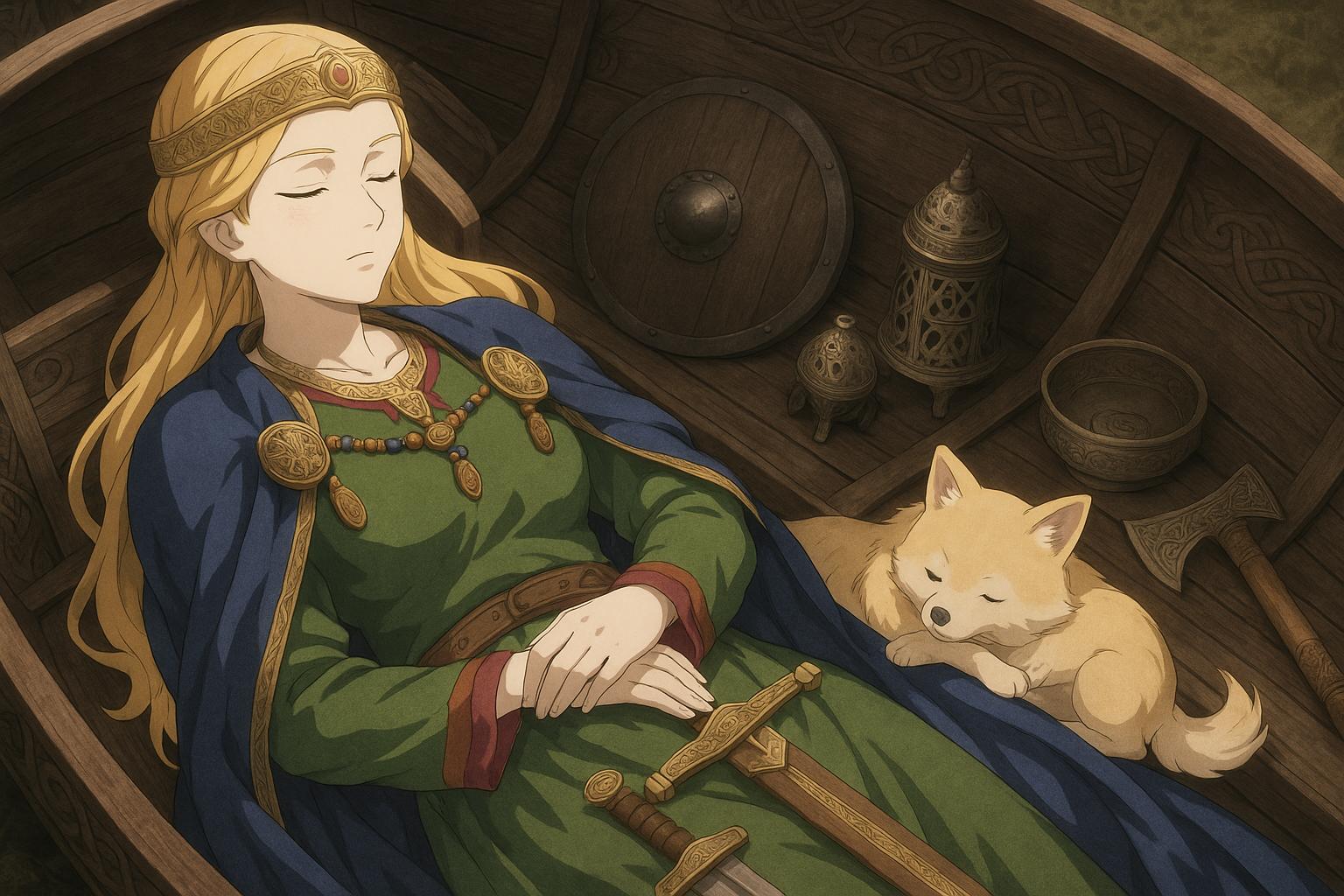Archaeologists uncover a 1,100-year-old Viking boat burial on Senja Island, revealing an elite woman interred with her pet dog and precious artefacts, shedding new light on Viking funerary customs and female status.
Archaeologists in Norway have made a remarkable discovery, unearthing the remains of a 10th-century Viking woman buried in a boat grave alongside her pet dog. This find, located on Senja Island, adds to the understanding of the distinctive funerary rituals that elite Vikings received, illuminating the complexities of their societal structures and beliefs.
The boat burial, a traditional Viking practice, typically involved interring the deceased within a ship, accompanied by an array of gifts ranging from jewellery to weapons, signalling their high status in life. In this instance, amateur metal detectorists stumbled upon the burial when they detected exposed bronze brooches in the earth, prompting them to contact experts from Norway’s Arctic University Museum. Subsequent excavations confirmed that the burial belonged to an elite woman who had lived over 1,100 years ago.
The remains were found in a 5.5-metre-long burial ship, positioned so that her head faced north. Alongside her were artefacts including an iron saw, a slate brow, potential bronze earrings, and two plate-shaped pearls possibly made of amber. Most notably, the skeleton of a small dog was discovered resting at her feet, suggesting a close bond even in death. As archaeologist Anja Roth Niemi explained, “only the elite would receive a burial like this,” underscoring the significance of the discovery.
The style of the boat itself indicates a crafting technique where the boat tables were sewn together rather than affixed with iron nails, reflecting a sophisticated level of Viking craftsmanship. Such nuances in burial practices are vital for understanding the era. Notably, researchers have identified that artefacts generally found in such burials have not yet appeared in male Viking burials, leading to the conclusion that these remains likely belonged to a woman of considerable importance within her community.
Further analysis of the skeletal remains could unearth details about her age, height, diet, and social status, potentially revealing significant aspects of her life as well. Dr. Niemi noted that insights into whether she experienced periods of poor nutrition or relocated throughout her life could provide crucial context about the role women played in Viking society.
The significance of this discovery is matched by other recent archaeological finds across Norway, where various Viking boat burials have been uncovered. For instance, a burial site discovered near Kvinesdal—the indicative scanning of which was prompted by upcoming road construction—has revealed another boat grave dating back for as long as a thousand years. While it remains unexcavated, this location is theorised to have been reserved for another high-status individual, reflecting similar cultural practices of the Viking Age.
In an unusual twist, a site at the Skeiet Viking farm even showcased a nested boat burial—where a woman’s grave was found within a boat containing the remains of a man laid to rest roughly a century earlier. Both graves provided rich archaeological material, including finely crafted jewellery and tools indicative of their life stages, thus expanding our understanding of evolving Viking burial customs.
As archaeological methods advance, such as the use of ground-penetrating radar, more remnants of Viking life are likely to be revealed, potentially reshaping the narratives surrounding this complex society and its beliefs about death and the afterlife. The recent findings underscore how much there still is to learn about the Vikings and their intricate cultural practices, particularly concerning elite women.
This latest excavation not only illuminates individual lives but also provides broader insights into the Viking world, challenging the long-standing narrative that largely overlooks the roles women played in their society.
 Reference Map:
Reference Map:
- Paragraph 1 – [1], [2]
- Paragraph 2 – [1], [3]
- Paragraph 3 – [1], [4]
- Paragraph 4 – [5], [6]
- Paragraph 5 – [2], [4]
Source: Noah Wire Services
- https://www.independent.co.uk/news/science/archaeology/viking-burial-boat-woman-pet-b2767093.html – Please view link – unable to able to access data
- https://www.livescience.com/viking-boat-burial-found-norway – Archaeologists have discovered a Viking boat burial near Kvinesdal in southwest Norway, dating back between 500 and 1,000 years. The boat, measuring approximately 8 to 9 meters in length, was identified through a ground radar survey conducted ahead of road construction. While no excavation has been performed yet, the presence of a boat suggests the burial was for an elite individual, as boat burials were typically reserved for high-status members of Viking society. The exact contents of the burial remain unknown until further excavation is conducted.
- https://www.livescience.com/two-viking-burials-in-boats.html – An unusual Viking burial site in Norway contains two stacked boats, each with a body. The upper boat, dating to the second half of the ninth century, held the remains of a woman adorned with two large shell-shaped brooches and a crucifix-shaped brooch. The lower boat, dating to the eighth century, contained the remains of a man accompanied by a shield, spear, and single-edged sword. This discovery provides valuable insights into Viking burial practices and the evolution of their material culture over time.
- https://arkeonews.net/new-huge-viking-age-boat-grave-discovered-by-radar-in-norway/ – Archaeologists have located a significant Viking Age boat grave near Øyesletta in Norway during a ground-penetrating radar survey. The boat, measuring between 8 to 9 meters, was placed beneath a burial mound. This discovery is notable not only because Viking ship burials are rare but also due to the site’s historical significance as one of Southern Norway’s largest known burial sites from the Iron and Viking Ages. The use of ground-penetrating radar has proven effective in uncovering such archaeological features.
- https://archaeologymag.com/2024/06/viking-ship-burial-unearthed-at-jarlsberg-manor/ – Archaeologists have confirmed the discovery of a Viking ship burial at Jarlsberg Manor, located northwest of Tønsberg in Vestfold county, Norway. The find stems from an initial discovery in 2018 when a metal detector survey at Jarlsberg Hovedgård uncovered scattered iron rivets. This led to a comprehensive study using ground-penetrating radar, which suggested the presence of a burial mound. The excavation unearthed around 70 rivets, indicating a large ship comparable to the famous Gokstad and Oseberg ships. The exact identity of the person buried in the ship remains speculative.
- https://www.smithsonianmag.com/smart-news/strange-viking-grave-includes-nested-boats-buried-100-years-apart-180973632/ – At the Skeiet Viking farm in Vinjeøra, Norway, archaeologists unearthed an unexpected burial: a boat containing the remains of a woman nested inside a second boat occupied by the body of a man laid to rest about 100 years earlier. The woman’s grave goods included a pearl necklace, two pairs of scissors, weaving tools, and a crucifix-shaped brooch made from an Irish harness fitting. This discovery sheds light on the evolution of Viking burial practices and the significance of boat burials over time.
- https://news.artnet.com/art-world/norwegian-ship-burial-2409608 – Scandinavia’s oldest ship burial has been found in Leka, in the northern part of Norway’s Trøndelag County. A small survey was undertaken at the Herlaugshaugen burial mound, and the team confirmed the presence of a ship when nails and rivets were found on the site. The burial, dating back more than 1,300 years, is now believed to be Norway’s oldest. This discovery suggests an earlier start to significant Scandinavian maritime expeditions than previously believed and provides valuable insights into the region’s ancient burial practices.













